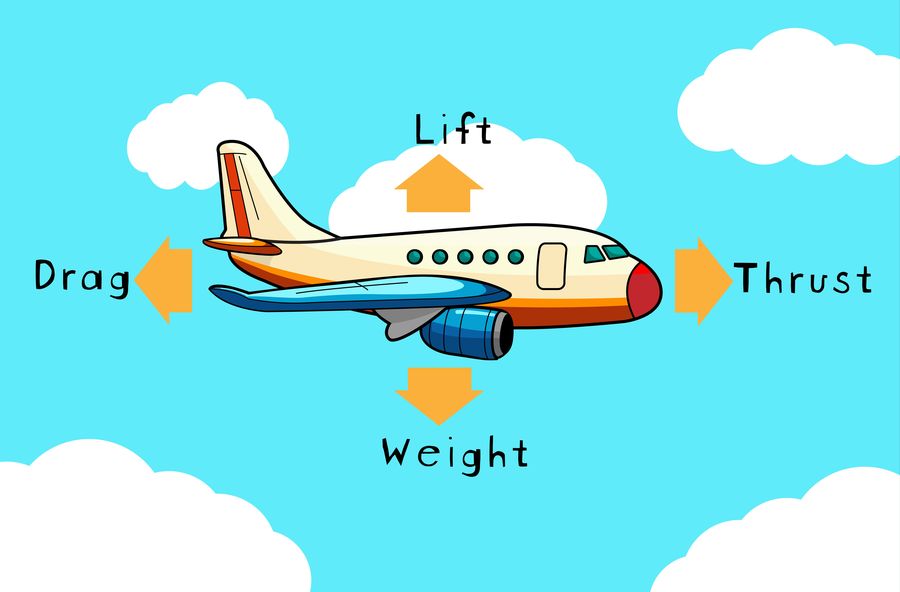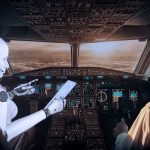Ever looked up at the sky and marveled at how massive airplanes manage to stay airborne? 🛩️ It’s not magic—it’s science! Specifically, the science of aerodynamics. At the heart of aviation are four fundamental forces that act on an aircraft in flight: Lift, Drag, Thrust, and Weight. These forces interact in harmony (or conflict!) to keep an aircraft flying—or to bring it back down.
In this article, we’ll explore each of these four forces in detail, how they interact, and how pilots and engineers manipulate them to achieve safe and efficient flight. Let’s take off! 🚀
🪁 1. Lift: The Force That Makes Flying Possible
Lift is the upward force that allows an aircraft to rise off the ground and stay in the air. It works against gravity (weight) and is generated primarily by the wings.
🔬 How Lift Works:
Lift is created when air flows over and under the wing, which is shaped in a special way (called an airfoil). The upper surface of the wing is curved, while the bottom is flatter. This shape causes air to move faster over the top than underneath, creating lower pressure above the wing. The result? The wing is pushed upward—that’s lift!
📈 Key Factors Affecting Lift:
-
Wing shape (airfoil design)
-
Angle of attack (the angle between the wing and the oncoming air)
-
Airspeed (faster air = more lift)
-
Air density (lift decreases at higher altitudes due to thinner air)
🧪 Fun Fact: The Bernoulli Principle explains how pressure differences create lift. However, Newton’s Third Law (every action has an equal and opposite reaction) also plays a role!
🌬️ 2. Drag: The Force That Slows You Down
Drag is the resistance force that acts opposite to the direction of motion. It’s like air pushing back against the airplane, trying to slow it down—just like wind against your face when you ride a bike! 🚴♂️
🧲 Types of Drag:
-
Parasite Drag – Comes from all non-lifting parts of the aircraft (e.g., fuselage, landing gear).
-
Induced Drag – Caused by the creation of lift, particularly at the wingtips.
-
Wave Drag – Occurs at high speeds near the speed of sound.
✈️ Designers reduce drag by streamlining aircraft bodies and using retractable landing gear. Pilots manage drag by adjusting their speed, flaps, and altitude.
🔥 3. Thrust: The Power That Pushes Forward
Thrust is the force that propels the aircraft forward. It is produced by engines—either propellers, turbofans, or jet engines. Thrust works against drag to keep the aircraft moving and climbing.
🛠 How Thrust Is Created:
-
Propeller Engines: Create thrust by pulling air backwards with spinning blades.
-
Jet Engines: Suck air in, compress it, ignite fuel, and blast it out the back to push the plane forward.
🔥 Thrust must be greater than drag for the plane to accelerate and take off. Once in the air, pilots adjust engine power to maintain cruise speed or climb rate.
🧠 Interesting Note: Space rockets also use thrust—but they don’t rely on air like airplanes do. They use fuel combustion in a vacuum!
🧲 4. Weight: Gravity’s Unrelenting Pull
Weight is the force of gravity pulling the aircraft toward the Earth. It acts straight down from the aircraft’s center of gravity and is always present.
📉 Why Weight Matters:
-
Every part of the aircraft—fuel, cargo, passengers—adds to its weight.
-
Pilots must ensure weight and balance are within limits for safe operation.
-
Too much weight, or poor distribution, can make flight unsafe or inefficient.
✈️ To achieve flight, lift must equal or exceed weight. When landing, pilots reduce thrust and let weight help bring the plane down gently.
⚖️ Balancing the Four Forces
Let’s visualize a plane in steady, level flight:
-
Lift = Weight
-
Thrust = Drag
This balance is crucial for maintaining altitude and speed. But when one force is greater than its opposite, the aircraft’s behavior changes:
| Situation | Force Relationship | Outcome |
|---|---|---|
| Takeoff | Thrust > Drag, Lift > Weight | Aircraft accelerates and climbs |
| Level flight | Thrust = Drag, Lift = Weight | Aircraft maintains flight |
| Descent | Lift < Weight | Aircraft descends |
| Deceleration | Thrust < Drag | Aircraft slows down |
Pilots continuously adjust these forces using throttle, flaps, elevators, and more.
👨✈️ Why These Forces Matter to Pilots and Students
Understanding the four forces of flight is foundational to learning how to fly. Whether you’re a budding pilot 🎓, an aviation enthusiast ✈️, or just someone who wants to understand the science behind air travel, knowing how these forces work equips you with a deeper appreciation for every flight.
🛫 Pilot’s Use of Forces:
-
Use thrust to accelerate and climb.
-
Manage lift with pitch and airspeed.
-
Reduce drag during cruise for efficiency.
-
Monitor weight for safe takeoff and landing performance.
🧠 Summary: The Four Forces at a Glance
| Force | Direction | Opposes | Created By |
|---|---|---|---|
| Lift | Upward | Weight | Wings (airflow) |
| Weight | Downward | Lift | Gravity |
| Thrust | Forward | Drag | Engines |
| Drag | Backward | Thrust | Air resistance |
Together, these forces define every moment of flight, from takeoff to touchdown. Mastering their interactions is key to safe and efficient flying!


